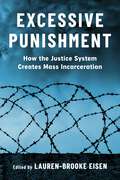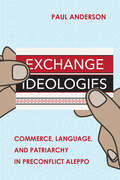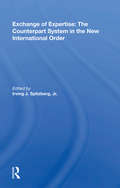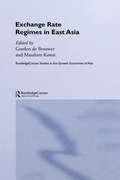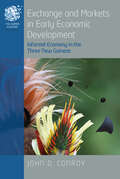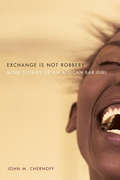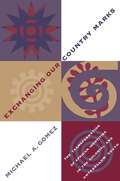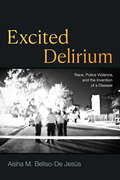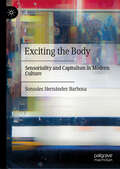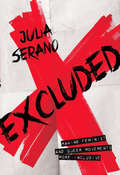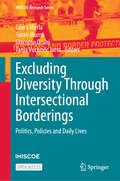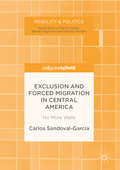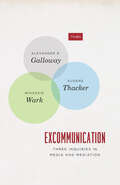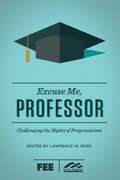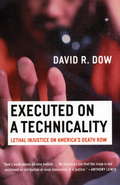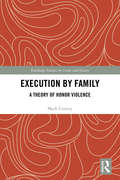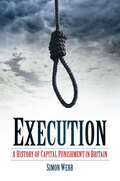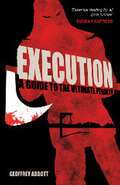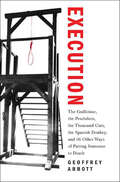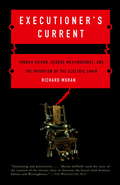- Table View
- List View
Excessive Punishment: How the Justice System Creates Mass Incarceration
by Lauren-Brooke EisenThe United States has by far the world’s largest population of incarcerated people. More than a million Americans are imprisoned; hundreds of thousands more are held in jails. This vast system has doled out punishment—particularly to people from marginalized groups—on an unfathomable scale. At the same time, it has manifestly failed to secure public safety, instead perpetuating inequalities and recidivism. Why does the United States see punishment as the main response to social harm, and what are the alternatives?This book brings together essays by scholars, practitioners, activists, and writers, including incarcerated and formerly incarcerated people, to explore the harms of this punitive approach. The chapters address a range of issues, from policing to prosecution, and from how people are treated in prison to the consequences of a criminal conviction. Together, they consider a common theme: We cannot reduce our dependence on mass incarceration until we confront our impulse to punish in ways that are excessive, often wildly disproportionate to the harm caused. Essays trace how a maze of local, state, and federal agencies have contributed to mass incarceration and deterred attempts at reform. They shed light on how the excesses of America’s criminal legal system are entwined with poverty, racism, and the legacy of slavery. A wide-ranging and powerful look at the failures of the status quo, Excessive Punishment also considers how to reimagine the justice system to support restoration instead of retribution.
Exchange Ideologies: Commerce, Language, and Patriarchy in Preconflict Aleppo
by Paul AndersonExchange Ideologies documents the social world of Aleppo's traders before the destruction of the city, exploring changing conceptions of commerce in Syria. Syria's traders have been seen as embodying a timeless culture of "the bazaar," or an ahistorical Islamic culture of trade. Other accounts portray them as venal figures, motivated only by profit, and commerce as a purely instrumental pursuit. Rejecting both approaches, Paul Anderson traces the diverse social structures, and notions of language, through which Aleppo's merchants understood and construed commerce and the figure of the merchant during a period of economic liberalization in the 2000s. Rather than seeing these social structures and representations as expressions of a timeless bazaar culture, or as shaped only by Islamic tradition, Exchange Ideologies relates them to processes of politically managed economic liberalization and the Syrian regime's attempts to ensure its own survival in the midst of change. In doing so, Anderson provides an account of economic liberalization in Syria as a social and cultural process as much as a political and economic one.
Exchange Of Expertise/h: The Counterpart System In The New International Order
by Irving J. SpitzbergThe vision of the New International Order emphasizes justice and equality. It also raises profound questions about the nature and future of the relationship between postindustrial and Third World countries. The counterpart system describes one aspect of this relationship: an expert from a postindustrial country teaches a special skill to a Third World national. In this collection contributors draw on political science, economics, education, sociology, history, and communications theory to illuminate the forces that shape the nature of the exchange of expertise between postindustrial and Third World countries. Each author raises theoretical points and offers practical observations about the future of this exchange—a critical point of contact--in the New International Order.
Exchange Rate Regimes in East Asia (Routledge Studies in the Growth Economies of Asia)
by Masahiro Kawai Gordon De BrouwerThere is a deepening debate in East Asia about the prospects for common exchange rate arrangements, even including the formation of a common currency in the longer term. This raises a complex set of issues and this volume provides a detailed yet comprehensive examination of key issues in the debate. It looks, for example, at the nature and extent of linkages in East Asia, in terms of trade and foreign investment, finance, labour, and consumption, investment and output. It examines how the exchange rate affects various aspects of economies. And it critically analyzes various proposals for currency regimes for the region, including floating exchange rates, basket pegs, and currency union.
Exchange and Markets in Early Economic Development: Informal Economy in the Three New Guineas (The Human Economy #10)
by John D. ConroyThe idea of an informal economy emerged from, and is a critique of, the ideology of ‘economic development’. It originated from Keith Hart’s recognition of informal economic activity in 1960s Ghana. In the context of four colonialisms – German, British, Australian and Dutch – this book recounts Hart’s effort in 1972 to introduce the informal ‘sector’ into development planning in Papua New Guinea. This was problematic, because ‘the market’ was scarcely institutionalized, and traditional modes of exchange persisted stubbornly. Rather than conforming with post-colonial economic ideology, the subjected people pushed back against imposed bureaucracy to practice informal and hybrid modes of economic activity.
Exchange is not Robbery: More Stories of an African Bar Girl
by John M. ChernoffWhile living in West Africa in the 1970s, John Chernoff recorded the stories of "Hawa," a spirited and brilliant but uneducated woman whose insistence on being respected and treated fairly propelled her, ironically, into a life of marginality and luck as an "ashawo," or bar girl. Rejecting traditional marriage options and cut off from family support, she is like many women in Africa who come to depend on the help they receive from one another, from boyfriends, and from the men they meet in bars and nightclubs. Refusing to see herself as a victim, Hawa embraces the freedom her lifestyle permits and seeks the broadest experience available to her. In Exchange Is Not Robbery and its predecessor, Hustling Is Not Stealing, a chronicle of exploitation is transformed by verbal art into an ebullient comedy. In Hustling Is Not Stealing, Hawa is a playful warrior struggling against circumstances in Ghana and Togo. In Exchange Is Not Robbery, Hawa returns to her native Burkina Faso, where she achieves greater control over her life but faces new difficulties. As a woman making sacrifices to live independently, Hawa sees her own situation become more complex as she confronts an atmosphere in Burkina Faso that is in some ways more challenging than the one she left behind, and the moral ambiguities of her life begin to intensify. Combining elements of folklore and memoir, Hawa's stories portray the diverse social landscape of West Africa. Individually the anecdotes can be funny, shocking, or poignant; assembled together they offer a sweeping critical and satirical vision.
Exchanging Objects: Nineteenth-Century Museum Anthropology at the Smithsonian Institution (Museums and Collections #12)
by Catherine A. NicholsAs an historical account of the exchange of “duplicate specimens” between anthropologists at the Smithsonian Institution and museums, collectors, and schools around the world in the late nineteenth century, this book reveals connections between both well-known museums and little-known local institutions, created through the exchange of museum objects. It explores how anthropologists categorized some objects in their collections as “duplicate specimens,” making them potential candidates for exchange. This historical form of what museum professionals would now call deaccessioning considers the intellectual and technical requirement of classifying objects in museums, and suggests that a deeper understanding of past museum practice can inform mission-driven contemporary museum work.
Exchanging Objects: Nineteenth-Century Museum Anthropology at the Smithsonian Institution (Museums and Collections)
by Catherine A. NicholsAs an historical account of the exchange of “duplicate specimens” between anthropologists at the Smithsonian Institution and museums, collectors, and schools around the world in the late nineteenth century, this book reveals connections between both well-known museums and little-known local institutions, created through the exchange of museum objects. It explores how anthropologists categorized some objects in their collections as “duplicate specimens,” making them potential candidates for exchange. This historical form of what museum professionals would now call deaccessioning considers the intellectual and technical requirement of classifying objects in museums, and suggests that a deeper understanding of past museum practice can inform mission-driven contemporary museum work.
Exchanging Our Country Marks
by Michael A. GomezThe transatlantic slave trade brought individuals from diverse African regions and cultures to a common destiny in the American South. In this comprehensive study, Michael Gomez establishes tangible links between the African American community and its African origins and traces the process by which African populations exchanged their distinct ethnic identities for onedefined primarily by the conception of race. He examines transformations in the politics, social structures, and religions of slave populations through 1830, by which time the contours of a new African American identity had begun to emerge.After discussing specific ethnic groups in Africa, Gomez follows their movement to North America, where they tended to be amassed in recognizable concentrations within individual colonies (and, later, states). For this reason, he argues, it is possible to identify particular ethnic cultural influences and ensuing social formations that heretofore have been considered unrecoverable. Using sources pertaining to the African continentas well as runaway slave advertisements, ex-slave narratives, and folklore, Gomez reveals concrete and specific links between particular African populations and their North American progeny, thereby shedding new light on subsequent African American social formation.
Excited Delirium: Race, Police Violence, and the Invention of a Disease
by Aisha M. Beliso-De JesúsIn 1980, Charles Wetli---a Miami-based medical examiner and self-proclaimed “cult expert” of Afro-Caribbean religions---identified what he called “excited delirium syndrome.” Soon, medical examiners began using the syndrome regularly to describe the deaths of Black men and women during interactions with police. Police and medical examiners claimed that Black people with so-called excited delirium exhibited superhuman strength induced from narcotics abuse. It was fatal heart failure that killed them, examiners said, not forceful police restraints. In Excited Delirium, Aisha M. Beliso-De Jesús examines this fabricated medical diagnosis and its use to justify and erase police violence against Black and Brown communities. Exposing excited delirium syndrome’s flawed diagnostic criteria, she outlines its inextricable ties to the criminalization of Afro-Latiné religions. Beliso-De Jesús demonstrates that it is yet a further example of the systemic racism that pervades law enforcement in which the culpability for state violence is shifted from the state onto its victims. In so doing, she furthers understanding of the complex layers of medicalized state-sanctioned violence against people of color in the United States.
Exciting the Body: Sensoriality and Capitalism in Modern Culture
by Sonsoles Hernández BarbosaThis book uncovers how during the origins of modernity in the nineteenth century the senses were mobilised to sell more, both through the popularisation of objects aimed at the senses (such as panoramas, optical boxes, automatons, music boxes and pianolas), and also through marketing mechanisms (for example, advertising and window dressing). All these novel objects and spaces had one thing in common: the aim of attracting the public by stimulating the senses. By examining practices that mobilised the senses in the emerging fields of advertising, marketing and the leisure industry, and through an approach that involves elements from the history of the senses, visual studies, sound studies and aesthetics, this book explores what this new sensory-driven mass culture was all about. The basis of English translation of this book, originally in Spanish Vidas excitadas. Sensorialidad y capitalismo en la cultura moderna (2022), was facilitated by artificial intelligence. The author, with the support of Lucille Banham, has subsequently revised the text further in an endeavour to refine the work stylistically.
Excluded: How Snob Zoning, NIMBYism, and Class Bias Build the Walls We Don't See
by Richard D KahlenbergAn indictment of America's housing policy that reveals the social engineering underlying our segregation by economic class, the social and political fallout that result, and what we can do about it The last, acceptable form of prejudice in America is based on class and executed through state-sponsored economic discrimination, which is hard to see because it is much more subtle than raw racism. While the American meritocracy officially denounces prejudice based on race and gender, it has spawned a new form of bias against those with less education and income. Millions of working-class Americans have their opportunity blocked by exclusionary snob zoning. These government policies make housing unaffordable, frustrate the goals of the civil rights movement, and lock in inequality in our urban and suburban landscapes. Through moving accounts of families excluded from economic and social opportunity as they are hemmed in through &“new redlining&” that limits the type of housing that can be built, Richard Kahlenberg vividly illustrates why America has a housing crisis. He also illustrates why economic segregation matters since where you live affects access to transportation, employment opportunities, decent health care, and good schools. He shows that housing choice has been socially engineered to the benefit of the affluent, and, that astonishingly the most restrictive zoning is found in politically liberal cities where racial views are more progressive. Despite this there is hope. Kahlenberg tells the inspiring stories of growing number of local and national movements working to tear down the walls that inflicts so much damage on the lives of millions of Americans.
Excluded: Making Feminist and Queer Movements More Inclusive
by Julia SeranoWhile many feminist and queer movements are designed to challenge sexism, they often simultaneously police gender and sexuality-sometimes just as fiercely as the straight, male-centric mainstream does. Among LGBTQ activists, there is a long history of lesbians and gay men dismissing bisexuals, transgender people, and other gender and sexual minorities. In each case, exclusion is based on the premise that certain ways of being gendered or sexual are more legitimate, natural, or righteous than others.As a trans woman, bisexual, and femme activist, Julia Serano has spent much of the last ten years challenging various forms of exclusion within feminist and queer/LGBTQ movements. In Excluded, she chronicles many of these instances of exclusion and argues that marginalizing others often stems from a handful of assumptions that are routinely made about gender and sexuality. These false assumptions infect theories, activism, organizations, and communities-and worse, they enable people to vigorously protest certain forms of sexism while simultaneously ignoring and even perpetuating others. Serano advocates for a new approach to fighting sexism that avoids these pitfalls and offers new ways of thinking about gender, sexuality, and sexism that foster inclusivity rather than exclusivity.
Excluding Diversity Through Intersectional Borderings: Politics, Policies and Daily Lives (IMISCOE Research Series)
by Laura Merla Sarah Murru Giacomo Orsini Tanja Vuckovic JurosThis open access book critically examines how discourses and policies target and exclude migrants and their families in Europe and North America along racial, gender and sexuality lines, and how these exclusions are experienced and resisted. Building on the influential notion of intersectional borderings, it delves deep into how these discourses converge and diverge, highlighting the underlying normative constructs of family, gender, and sexuality. First, it examines how radical-right and conservative political movements perpetuate exclusionary practices and how they become institutionalized in migration, welfare, and family policies. Second, it examines the dynamic responses they provoke—both resistance and reinforcement—among those affected in their everyday lives. Bringing together studies from political and social sciences, it offers a vital contribution to the expanding field of migrant family governance and exclusion and is essential for understanding the complex processes of exclusion and the movements that challenge and sustain them. It expands academic discussions on populism and the politics of exclusion by linking them to the politicization of intimacy and family life. With diverse case studies from Europe, North, and Central America, it appeals to students, academics, and policymakers, informing future mobilizations against discriminatory and exclusionary tendencies in politics and society.
Exclusion and Forced Migration in Central America: No More Walls (Mobility & Politics)
by Carlos Sandoval-GarcíaThis book marks a critical contribution to the intercultural dialogue about immigration. Each year, thousands of Central Americans leave their countries and walk across Mexico, seeking to reach the United States. The author explores the dispossession process that drives these migrants from their homes and argues that they are caught in a kind of trap: forced to emigrate, but impeded to immigrate. This trap is discussed empirically through the analysis of immigration policies implemented by the United States government and ethnographic fieldwork carried out in some of “albergues” (shelters).
Excommunication: Three Inquiries in Media and Mediation (TRIOS)
by Alexander R. Galloway Eugene Thacker McKenzie WarkAlways connect—that is the imperative of today’s media. But what about those moments when media cease to function properly, when messages go beyond the sender and receiver to become excluded from the world of communication itself—those messages that state: “There will be no more messages”? In this book, Alexander R. Galloway, Eugene Thacker, and McKenzie Wark turn our usual understanding of media and mediation on its head by arguing that these moments reveal the ways the impossibility of communication is integral to communication itself—instances they call excommunication. In three linked essays, Excommunication pursues this elusive topic by looking at mediation in the face of banishment, exclusion, and heresy, and by contemplating the possibilities of communication with the great beyond. First, Galloway proposes an original theory of mediation based on classical literature and philosophy, using Hermes, Iris, and the Furies to map out three of the most prevalent modes of mediation today—mediation as exchange, as illumination, and as network. Then, Thacker goes boldly beyond Galloway’s classification scheme by examining the concept of excommunication through the secret link between the modern horror genre and medieval mysticism. Charting a trajectory of examples from H. P. Lovecraft to Meister Eckhart, Thacker explores those instances when one communicates or connects with the inaccessible, dubbing such modes of mediation “haunted” or “weird” to underscore their inaccessibility. Finally, Wark evokes the poetics of the infuriated swarm as a queer politics of heresy that deviates from both media theory and the traditional left. He posits a critical theory that celebrates heresy and that is distinct from those that now venerate Saint Paul. Reexamining commonplace definitions of media, mediation, and communication, Excommunication offers a glimpse into the realm of the nonhuman to find a theory of mediation adequate to our present condition.
Excuse Me, Professor: Challenging the Myths of Progressivism
by Ron Robinson Lawrence W. ReedThere's little truly "progressive" about Progressivism. True progress happens when humans are free, yet the Progressive agenda substantially diminishes freedom while promising the unachievable. Excuse Me, Professor provides a handy reference for anyone actively engaged in advancing liberty, with essential essays debunking more than 50 Progressive clichés.Does the free market truly ignore the poor? Are humans really destroying the Earth? Is the government truly the first best source to relieve distress?Compiled and edited by Lawrence W. Reed in collaboration with the Foundation for Economic Education and Young America's Foundation, this anthology is an indispensable addition to every freedom lover's arsenal of intellectual ammunition.
Executed on a Technicality
by David DowWhen David Dow took his first capital case, he supported the death penalty. He changed his position as the men on death row became real people to him, and as he came to witness the profound injustices they endured: from coerced confessions to disconcertingly incompetent lawyers; from racist juries and backward judges to a highly arbitrary death penalty system.It is these concrete accounts of the people Dow has known and represented that prove the death penalty is consistently unjust, and it's precisely this fundamental-and lethal-injustice, Dow argues, that should compel us to abandon the system altogether.From the Trade Paperback edition.
Executing Magic in the Modern Era
by Owen Davies Francesca MatteoniThis book is open access under a CC BY 4. 0 license This book explores the magical and medical history of executions from the eighteenth to the early twentieth century by looking at the afterlife potency of criminal corpses, the healing activities of the executioner, and the magic of the gallows site. The use of corpses in medicine and magic has been recorded back into antiquity. The lacerated bodies of Roman gladiators were used as a source of curative blood, for instance. In early modern Europe, a great trade opened up in ancient Egyptian mummies and the fat of executed criminals, plundered as medicinal cure-alls. However, this is the first book to consider the demand for the blood of the executed, the desire for human fat, the resort to the hanged man's hand, and the trade in hanging rope in the modern era. It ends by look at the spiritual afterlife of dead criminals.
Execution Culture in Nineteenth Century Britain: From Public Spectacle to Hidden Ritual (Routledge SOLON Explorations in Crime and Criminal Justice Histories)
by Patrick Low Helen Rutherford Clare Sandford-CouchThis edited collection offers multi-disciplinary reflections and analysis on a variety of themes centred on nineteenth century executions in the UK, many specifically related to the fundamental change in capital punishment culture as the execution moved from the public arena to behind the prison wall. By examining a period of dramatic change in punishment practice, this collection of essays provides a fresh historical perspective on nineteenth century execution culture, with a focus on Scotland, Wales and the regions of England. From Public Spectacle to Hidden Ritual has two parts. Part 1 addresses the criminal body and the witnessing of executions in the nineteenth century, including studies of the execution crowd and executioners’ memoirs, as well as reflections on the experience of narratives around capital punishment in museums in the present day. Part 2 explores the treatment of the execution experience in the print media, from the nineteenth and into the twentieth century. The collection draws together contributions from the fields of Heritage and Museum Studies, History, Law, Legal History and Literary Studies, to shed new light on execution culture in nineteenth century Britain. This volume will be of interest to students and academics in the fields of criminology, heritage and museum studies, history, law, legal history, medical humanities and socio-legal studies.
Execution by Family: A Theory of Honor Violence (Routledge Studies in Crime and Society)
by Mark CooneyAcross many parts of the world, violence inflicted in the name of family honor is attracting an increasing amount of attention. Family honor violence, otherwise known as honor-based violence, is physical force inflicted primarily on women for conduct defined as dishonorable. This book explores these conflicts of honor, how they are triggered, how they are handled, and why some lead to death. Drawing on a range of case studies and employing Donald Black’s concept of social geometry, Execution by Family incorporates and goes beyond patriarchy, culture, and kinship to develop a unified theory of family honor violence. It discusses the "honor belt," a series of countries stretching from north Africa to southeast Asia, in which similar forms of inequality, patriarchy, group authority, and gerontocracy are prevalent and how, within the confines of this inequality, honor violence flourishes. Reviewing survey data and pointing to a multi-pronged, cross-national social movement, the book also discusses the future of honor-based violence. Given the growing awareness of family honor violence, Execution by Family will be of interest to anybody concerned with family conflict, violence, crime, and popular morality. It will be invaluable reading for academics and students in the fields of criminology, criminal justice, sociology, social psychology, and anthropology.
Execution: A History of Capital Punishment in Britain
by Simon WebbJudicial hanging is regarded by many as being the quintessentially British execution. However, many other methods of capital punishment have been used in this country; ranging from burning, beheading and shooting to crushing and boiling to death. This book explores these types of execution in detail. Readers may be surprised to learn that a means of mechanical decapitation, the Halifax Gibbet, was being used in England five hundred years before the guillotine was invented. Boiling to death was a prescribed means of execution in this country during the Tudor period. From the public death by starvation of those gibbeted alive, to the burning of women for petit treason, this book examines some of the most gruesome passages of British history.
Execution: A guide to the Ultimate Penalty
by Geoffrey AbbottExecution is a fascinating account of methods of execution through the ages, such as death by cannibalism, being sewn into an animal’s belly and a thousand cuts. From the preparation of the victim to the disposal of the body, Execution answers all the questions you are ever likely to ask, and some you would never want to imagine.
Execution: The Guillotine, the Pendulum, the Thousand Cuts, the Spanish Donkey, and 66 Other Ways of Putting Someone to Death
by Geoffrey AbbottIn his own darkly humorous style, Geoffrey Abbott describes the instruments used and their effectiveness and reveals the macabre origins of familiar phrases such as "gone west" or "drawn a blank," as well as the jargon of the underworld. He covers everything from the preparation of the victim to the disposal of the body. Execution is everything you ever wanted to know about the ultimate penalty---and a lot you never thought to ask. It includes such hair-raising categories as: · Cave of Roses: A rare Swedish method of execution in which the victim was confined to a cave full of snakes and poisonous reptiles.· Bastinado: Involved the victim being caned gently and rhythmically with a lightweight stick on the soles of the feet until the mental collapse and eventual death of the victim.· Sewn in an Animal's Belly: A living person is sewn into the belly of an animal and left to die.· The Spanish Donkey: This method of torture consisted of seating a victim on top of a wall that resembled an inverted "v" with weights attached to the ankles, the weights slowly increased until the victim's body split in two.· Iron Chair: The victim is tied to an iron armchair and pushed nearer and nearer to a blazing fire. · Sawn in Half: Victims are secured in a standing position, pinned between two wide boards fixed between a stake driven deep into the ground while two executioners (one on each side) would wield a long, two-handled saw downwards through the boards. Execution is a unique fascinating look at the grim and gritty history of sanctioned death.
Executioner's Current: Thomas Edison, George Westinghouse, and the Invention of the Electric Chair
by Richard MoranIn this amazing story of high stakes competition between two titans, Richard Moran shows how the electric chair developed not out of the desire to be more humane but through an effort by one nineteenth-century electric company to discredit the other. In 1882, Thomas Edison ushered in the "age of electricity" when he illuminated Manhattan's Pearl Street with his direct current (DC) system. Six years later, George Westinghouse lit up Buffalo with his less expensive alternating current (AC). The two men quickly became locked in a fierce rivalry, made all the more complicated by a novel new application for their product: the electric chair. When Edison set out to persuade the state of New York to use Westinghouse's current to execute condemned criminals, Westinghouse fought back in court, attempting to stop the first electrocution and keep AC from becoming the "executioner's current." In this meticulously researched account of the ensuing legal battle and the horribly botched first execution, Moran raises disturbing questions not only about electrocution, but about about our society's tendency to rely on new technologies to answer moral questions. From the Trade Paperback edition.
